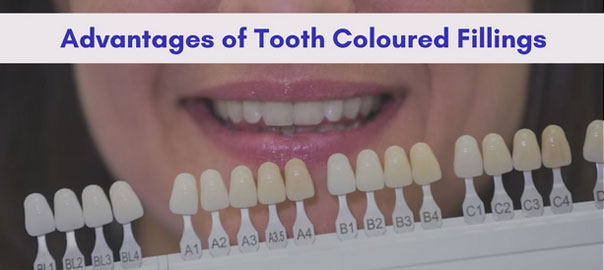
What are the benefits of Tooth Coloured Fillings?
Table of Contents
Dental health is a crucial aspect of overall well-being, and maintaining strong and healthy teeth is essential for a confident smile and effective chewing. One of the key developments in modern dentistry has been the introduction of tooth-coloured fillings, also known as composite fillings.
Unlike traditional amalgam fillings that are noticeable due to their metallic appearance, tooth-coloured fillings offer numerous advantages that go beyond their aesthetic appeal. In this blog, we will delve into the world of tooth-coloured fillings, exploring their benefits and shedding light on why they have become the preferred choice for many patients.
Aesthetics and Natural Appearance
- One of the most noticeable benefits of tooth-coloured fillings is their ability to blend seamlessly with the natural color of your teeth.
- Composed of a mixture of resin and finely ground glass particles, these fillings can be precisely matched to the shade of your existing teeth.
- This results in a virtually invisible restoration, making tooth-coloured fillings an excellent choice for visible areas of the mouth, such as the front teeth and smile line.
- The ability to maintain a natural appearance while addressing dental issues is a major draw for individuals who are conscious of their smile’s aesthetics.
Conservative Tooth Preparation
- Tooth-coloured fillings require less removal of healthy tooth structure compared to traditional amalgam fillings.
- This conservative approach to tooth preparation is a significant advantage, as it helps preserve more of your natural tooth.
- With amalgam fillings, a dentist may need to remove more healthy tooth material to create space for the filling, which can weaken the tooth over time.
- Tooth-coloured fillings, on the other hand, bond directly to the tooth structure, allowing for a smaller, more precise restoration and helping to maintain the tooth’s overall strength.
Biocompatibility and Reduced Sensitivity
- Composite fillings are made from biocompatible materials that are well-tolerated by the body.
- This reduces the risk of allergic reactions or other adverse responses that can sometimes occur with amalgam fillings.
- Additionally, tooth-coloured fillings have been found to cause less post-operative sensitivity compared to their amalgam counterparts.
- This is particularly beneficial for individuals who may already experience tooth sensitivity or discomfort, as tooth-coloured fillings can provide a more comfortable restoration experience.
Versatility and Cosmetic Enhancements
- Tooth-coloured fillings are not only suitable for repairing cavities but can also be used for various cosmetic enhancements.
- Dentists can use composite material to reshape teeth, close gaps, and even alter the appearance of misaligned teeth.
- This versatility allows for a comprehensive approach to smile design and aesthetic improvements.
- Patients seeking to address both functional and cosmetic concerns can benefit from tooth-coloured fillings’ ability to deliver reliable and pleasing results.
Mercury-Free and Health Considerations
- Amalgam fillings have long been a topic of debate due to their mercury content.
- Tooth-coloured fillings are mercury-free, offering peace of mind to those who are wary of potential health risks associated with amalgam fillings.
- This factor has contributed to the growing popularity of tooth-coloured fillings as a safer alternative.
Durability and Longevity
- Advancements in dental technology have led to the development of high-quality composite materials that exhibit remarkable durability and longevity.
- Tooth-coloured fillings can withstand the forces of chewing and biting, making them a reliable option for restoring both front and back teeth.
- With proper oral hygiene and regular dental check-ups, tooth-coloured fillings can last for many years, providing a lasting solution for dental restoration needs.
Bonding Strength and Reinforcement
- The bonding process used for tooth-coloured fillings involves applying a bonding agent to the tooth before placing the composite material.
- This bonding mechanism enhances the filling’s structural integrity and reinforces the tooth’s overall strength.
- Unlike amalgam fillings, which rely on mechanical retention, composite fillings chemically bond to the tooth surface.
- This results in a restoration that helps to support and stabilize the remaining tooth structure, reducing the risk of fracture and other issues down the road.
Ease of Repair and Maintenance
- In the event that a tooth-coloured filling becomes chipped, worn, or damaged over time, repairs are relatively straightforward.
- Dentists can easily repair or replace a damaged composite filling without having to remove the entire restoration.
- This ease of repair minimizes the need for extensive dental work and helps to maintain the tooth’s original strength and integrity.
- Routine maintenance of tooth-coloured fillings involves regular dental visits for cleaning and check-ups, similar to the care required for natural teeth.
Conclusion
Tooth-coloured fillings have revolutionized the field of dentistry by providing a versatile, aesthetic, and patient-friendly alternative to traditional amalgam fillings. From their natural appearance and conservative tooth preparation to their biocompatibility and longevity, the benefits of tooth-coloured fillings are numerous and far-reaching.
As dental technology continues to evolve, these fillings are likely to remain a preferred choice for patients seeking both functional restorations and cosmetic enhancements. By choosing tooth-coloured fillings, individuals can enjoy a confident smile and optimal oral health while reaping the rewards of modern dental innovation.
Leave a Reply
Leave a Reply
Explore More Similar Posts
Explore More Blogs


Leave a Reply